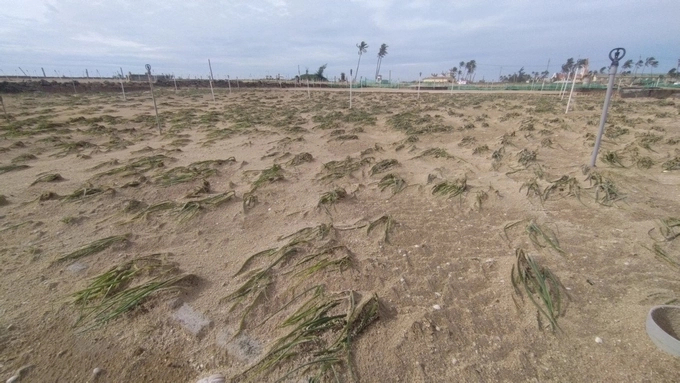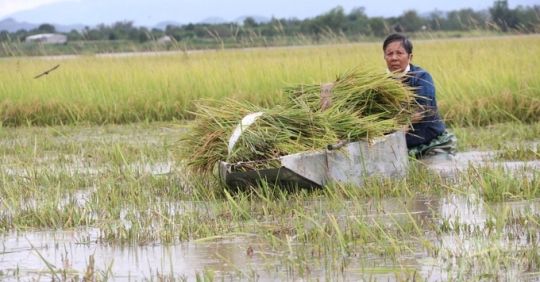According to the Irrigation Works Management Department (General Department of Irrigation – Department of Agriculture and Rural Development), as of 4:00 p.m. on September 28, the Central and Central Highlands regions had about 212,577 hectares of unharvested rice, accounting for about 29% of the rice sown Summer-autumn, 2022 season.
In the North Central region, the unharvested area is approximately 47,500ha / 320,000ha planted, accounting for 14.8%. The unharvested area in the South Central Region is 48,728 ha/266,857 ha planted, which is 18.3%. In the Central Highlands, the area of unharvested rice is 116,349 ha/147,525 ha, accounting for 78.9%.

Farmers in Krong Pac (Dak Lak) district harvest rice to flee flooding from Typhoon No. 4. Photo: Minh Qui.
Due to the impact of Typhoon Noru, about 431 ha (90 ha rice, 341 ha vegetables) collapsed and flooded in the South Central region, including 79 ha in Da Nang city, 262 ha in Quang Ngai province, 90 ha in the Binh Dinh Province (other locations are under construction during statistics).
In the central highlands, there are about 962 hectares of affected crops (rice 270.5 hectares, other crops 692 hectares), including Kon Tum 262 hectares, Gia Lai 700.5 hectares (other locations are in statistics).
Mr. Nguyen Manh Hung, deputy director of the Department of Irrigation Facilities Management, said that the General Irrigation Department continues to urge communities to implement the contents of the official notice No. 1518/CD-TCTL-QLCT dated September 25, 2022 to ensure the safety of Irrigation works preventing the effects of Typhoon #4 in the central provinces from Thanh Hoa to Binh Thuan and Gia Lai and Kon Tum.
Regarding the situation of the irrigation reservoirs, the average amount of water stored in the reservoirs reached 39% – 93% of the design capacity in the afternoon of September 28 in the South Central region. Of which Quang Nam Province 55% (up 10% compared to September 27), Quang Ngai 48% (up 6%), Binh Dinh 39% (up 16%), Phu Yen 42%, Khanh Hoa 70%, Ninh Binh Thuan Province 65%, Binh Thuan 86%. Some reservoirs store flood water like: Suoi Trau (Khanh Hoa) 106%, Tan Giang (Ninh Thuan) 99%…
Some large reservoirs still have capacity to store floods. As of this writing, Lake Nuoc Trong has a water level of about 115.67/129.5 m (normal water level rise), an increase of 2.13 m from September 27. The Q inflow (amount of water to the lake) is 531 m3/s, while the Q outflow is 42.3 m3/s. The lake still has 137 million m3 left for flood storage.

Storm No. 4 hit many crops in Quang Ngai province. Photo: tsp.
At Phu Ninh Lake, the current water level is 24.25/32m (normal water level), an increase of 2.1m compared to September 27. The lake still has 202 million m3 left for flood storage.
The water level rise in Binh Dinh Lake is 66.9/91.93m (normal water level rise), 4.68m lower compared to September 27, the lake has 203 million m3 for flood storage.
Earlier on September 25, the General Department of Irrigation had sent an explicit message to the Departments of Agriculture and Rural Development in the provinces/cities of North Central, South Central and Central Highlands; Provincial and municipal project management bodies manage irrigation repair and upgrade projects; Cua Dat and Ta Trach Irrigation Works One Member Co., Ltd. proposed to implement plans to ensure the safety of irrigation works and prevent the impact of Typhoon No. 4 (Noru).
Accordingly, the units actively monitor weather information, rain and storm forecasts of specialized hydrometeorological agencies, specialized agencies of the Ministry of Agriculture and Rural Development, and the instruction of the relevant authorities the right to implement the plan to ensure safety and operate irrigation works to to ensure the operation of production and the daily life of people in the event of flooding or waterlogging.
The units zoned growing areas at risk of flooding and flooding and prepared appropriate response solutions. At the same time, irrigation systems should be proactively operated early on to release buffer water and release water to ensure damage is minimized in the event of flooding or waterlogging. At the same time, implement the plan to ensure the safety of irrigation works, paying special attention to the safety of reservoirs under construction, critical reservoirs, reservoirs filled with water and with high water storage levels.
For reservoirs with flood gates, adjust the lake water level to actively welcome floods, ensure absolute safety of works, and do not conduct abnormal discharges causing safety in downstream areas; at the same time make sensible water storage for reservoirs with low storage capacity. Be sure to introduce early warning to people in downstream areas before the reservoir floods and when there is a risk of an incident.
For reservoirs with high storage levels, units must closely monitor incoming water flow in order to have an appropriate operational plan; deal with abnormal situations promptly according to the motto “4 on site” in the event of impending construction incidents.

